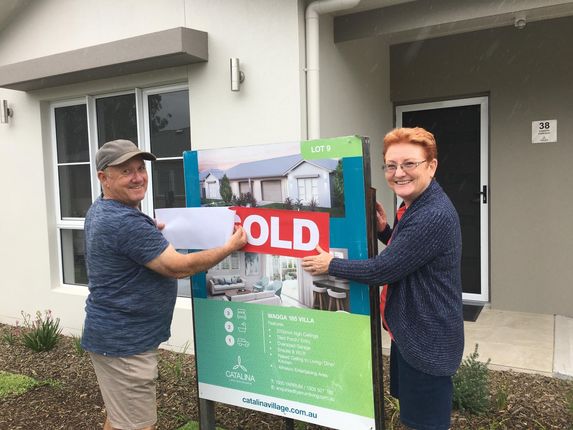Potential downsizers have the opportunity to follow the advice of British wartime leader Winston Churchill, who famously said that you should “never let a good crisis go to waste".
If Mr Churchill were alive today, he would surely agree we are going through a crisis - albeit one relating to the economy rather than national security.
Figures released today by the Australian Bureau of Statistics show that between 14 March and 4 April, the number of jobs decreased by 6 per cent and total wages fell by 6.7 per cent.
Meanwhile, real estate insights company CoreLogic has reported that a strong early 2020 capital city home price market rally has ended.
Despite this, there is still plenty of downsizing activity taking place across the nation.
In fact, Downsizing.com,au has seen its listing page views improve over the last ten days, as people appear to have recovered from the initial shock of the coronavirus situation.
Below are four reasons why people are still considering downsizing.
-
Take advantage of current housing market
AMP Chief Economist Shane Oliver has a view that the Australian Government’s economic stimulus package, and loan holidays by major banks, should keep a floor under house prices for the next six months.
At the same time, as outlined by CoreLogic there has been a significant drop-off in new properties coming to the market, compared to the same period last year.
If these scenarios continue to play out, downsizers will have the opportunity - at least in the short-term - to take advantage of a stabilised market and less competition to sell their family home.
Importantly, downsizers typically are selling homes without a mortgage, and therefore have the ability to test the market, without being forced sellers. This means they can set their preferred selling price and lead, rather than follow, the market.
-
Boost retirement income
Downsizing at this time provides the potential to boost retirement income, during a period of significant share market uncertainty.
In fact, while capital city home prices fell 7.5 per cent during the global financial crisis of the late 2000s, the share market tanked an incredible 55 per cent.
This historic fact highlights the need to consider the potential for downsizing to boost retirement income, as a hedge against a falling share market.
In fact, Australian couples are typically giving their retirement savings a $200,000 boost as a result of downsizing from the family home, including through using the Australian Government’s downsizing superannuation incentive.
On 3 April, McGrath real estate agent, Betty Ockerlander, helped her downsizing vendors sell a three-bedroom home in Sydney’s Epping for $1.32 million, via an online auction. The vendors were selling up to move to the Blue Mountains.
Ms Ockerlander said she was finding that downsizers, including her Epping vendors, were keen to extract maximum value from their family home before seeing further falls in their superannuation savings.
“My Epping vendors wanted to retire and get out of Sydney soon rather than later,” Ms Ockerlander said. “We started the sale process right in the thick of the coronavirus situation and then brought forward the auction when we had a fair idea of where the market was.”
-
Move into a supportive environment
Retirement and lifestyle communities are actually a great place for retirees during the current pandemic, because of the supportive environment they provide residents (which wouldn’t ordinarily be available to retirees were living in the general community).
For instance, many retirement communities have organised food and pharmaceutical deliveries for their residents, along with appropriate social and community network events. This has been helping keep residents physically and mentally healthy.
In a recent article, Downsizing.com.au published the personal stories of several self-isolating retirement community residents who are sharing friendship, fun and food.
-
Escape from the city
There is preliminary evidence that the coronavirus situation has prompted many potential downsizers to think about a move out of crowded city environments, to less dense and cleaner rural and regional environments.
For instance, Boyd McCallum, the project director at Catalina Village at Cooranbong in the Lake Macquarie area of NSW, says that his new retirement village project has seen a strong uptick in enquiries since the start of the virus situation.
“We saw a very sharp increase in enquiry when COVID-19 first hit,” Mr McCallum said.
“In many cases people who had been on our database for years and had been procrastinating were coming back through the door and depositing. They were.often being guided by family to finally bite the bullet and get going.”
Mr McCallum said the buyers appeared to be motivated by looking after their health and well-being, along with finding companionship.
He said they were also keen to boost their retirement income, by capitalising on the cost differential between their family home and a home in his village.
“Our average sale price in Lake Macquarie is still $120-$150,000 less than Central Coast, which is only 20 minutes down the road,” he said.

at the new Catalina retirement community at Lake Macquarie
Meanwhile, the developer of a freehold over 55s seniors housing development in southern NSW says he has also seen an increase in interest from people keen to enjoy “the fresh clean country air and isolation”.
Tim Wright is developing the Summerfield community at Braidwood, which includes 56 three bedroom villas (of which 25 homes have already been built and sold). The community also includes a clubhouse, indoor heated pool and arts and crafts room.
He says he is attracting buyers from as far as Hobart and Sydney, who are keen to enjoy the rural environment but also collect some of the equity from their capital city family home sale. Villa prices start at $585,000.

complete, at Braidwood in southern NSW



